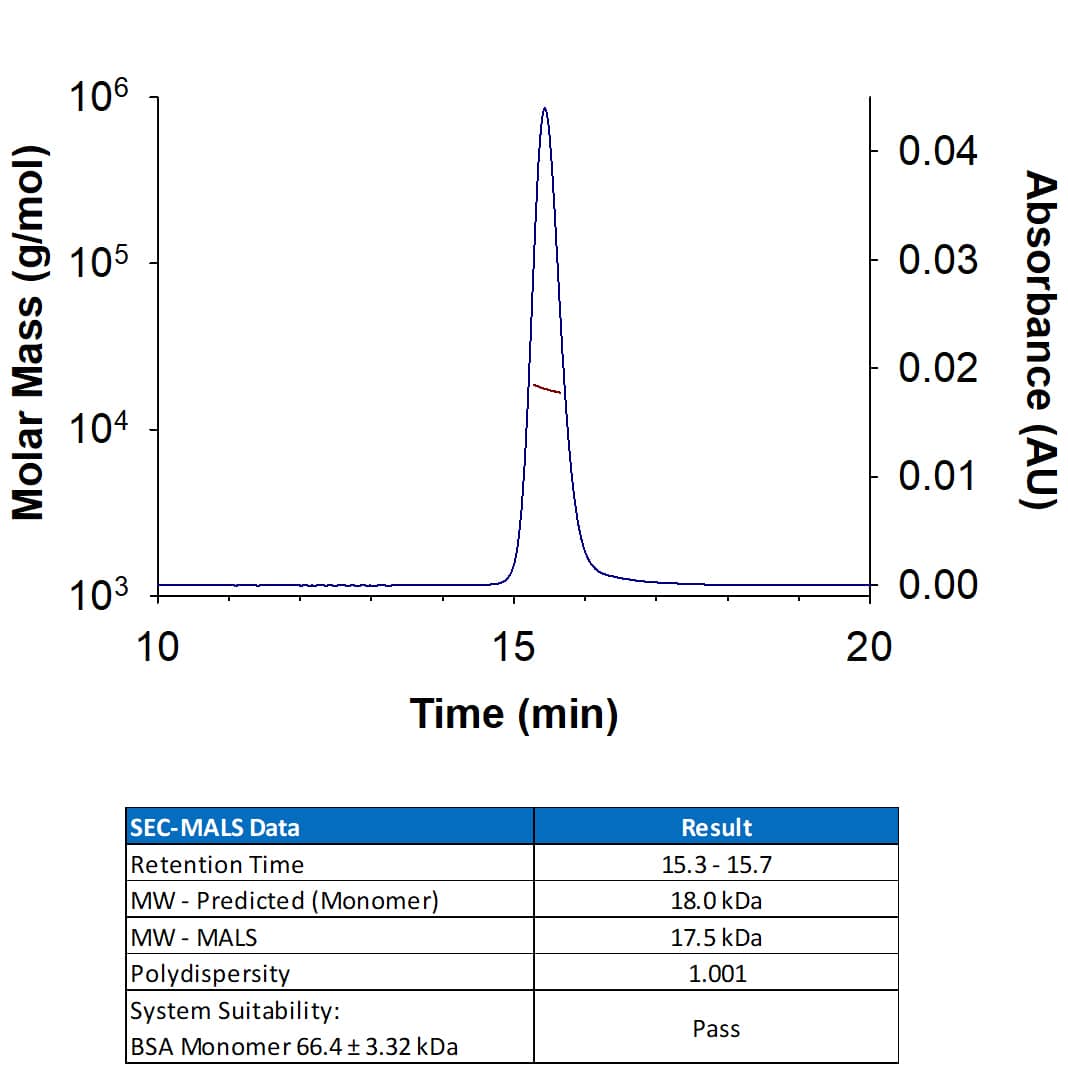Recombinant Mouse DR3/TNFRSF25 Fc Chimera Protein, CF Summary
Product Specifications
| Mouse DR3 (Gln31-Phe199) Accession # AAK11256 |
IEGRMD | Human IgG1 (Pro100-Lys330) |
| N-terminus | C-terminus | |
Analysis
Customers also Viewed
Product Datasheets
Carrier Free
CF stands for Carrier Free (CF). We typically add Bovine Serum Albumin (BSA) as a carrier protein to our recombinant proteins. Adding a carrier protein enhances protein stability, increases shelf-life, and allows the recombinant protein to be stored at a more dilute concentration. The carrier free version does not contain BSA.
In general, we advise purchasing the recombinant protein with BSA for use in cell or tissue culture, or as an ELISA standard. In contrast, the carrier free protein is recommended for applications, in which the presence of BSA could interfere.
2437-D3
| Formulation | Lyophilized from a 0.2 μm filtered solution in PBS. |
| Reconstitution | Reconstitute at 100 μg/mL in sterile PBS. |
| Shipping | The product is shipped at ambient temperature. Upon receipt, store it immediately at the temperature recommended below. |
| Stability & Storage: | Use a manual defrost freezer and avoid repeated freeze-thaw cycles.
|
Background: DR3/TNFRSF25
Death receptor 3 (DR3), also known as TNFRSF25, LARD, WSL-1, APO3, TRAMP, and TR3, is a 55 kDa TNF receptor superfamily protein that is predominantly expressed by lymphocytes. TNF receptor superfamily members have varying numbers of extracellular cysteine-rich domains (CRDs) with conserved cysteine spacing (1, 2). DR3 contains four CRDs and one cytoplasmic death domain (3, 4). Alternative splicing of mouse DR3 generates an isoform that lacks the fourth CRD and a secreted isoform that consisits of only the extracellular domain (ECD) (3). Human DR3 exists in at least eleven alternate splice forms (5). Within the ECD, mouse and human DR3 share 59% amino acid (aa) sequence identity. DR3 shares 20%-28% aa sequence identity with the ECD of death domain receptors DR5, DR6, EDAR, Fas, NGF R, and TNF RI. Naïve B and T cells preferentially express truncated soluble isoforms of DR3, whereas stimulated lymphocytes preferentially express transmembrane DR3 (5). TL1A/TNFSF15, a high affinity DR3 ligand which also exists in membrane bound and soluble forms, is expressed by activated endothelial cells and T cells (6, 7). TL1A additionally binds to DcR3/TNFRSF6B, a soluble decoy receptor that interferes with DR3 activation (8). DR3 signaling triggers either apoptosis or NF kappa B-induced anti-apoptotic effects depending on the cellular setting (9). Apoptosis is partially impaired during negative selection of thymocytes in DR3-null mice (10). TL1A interactions with DR3 augment T cell proliferation and proinflammatory cytokine secretion (6, 7, 11, 12). DR3 is upregulated by inflammatory stimulation of CCR9+ T cells, a T cell subset important in mucosal immunity (11). T cell and macrophage DR3 expression is prominent in several inflammatory disorders such as Crohn’s disease, inflammatory bowel disease, and atherosclerosis (7, 11-15). DR3 activation on IFN-gamma treated THP-1 cells induces the production of TNF-alpha, CXCL8, CCL2, MMP-1, -9, and -13 (14, 15).
- Fas, S.C. et al. (2006) Curr. Dir. Autoimmun. 9:1.
- Aggarwal, B.B. (2003) Nat. Rev. Immunol. 3:745.
- Wang, E.C.Y. et al. (2001) Immunogenetics 53:59.
- Borysenko, C.W. et al. (2005) Biochem. Biophys. Res. Commun. 328:794.
- Screaton, G.R. et al. (1997) Proc. Natl. Acad. Sci. USA 94:4615.
- Migone, T.S. et al. (2002) Immunity 16:479.
- Prehn, J.L. et al. (2004) Clin. Immunol. 112:66.
- Yang, C.-R. et al. (2004) Cancer Res. 64:1122.
- Wen, L. et al. (2003) J. Biol. Chem. 278:39251.
- Wang, E.C.Y. et al. (2001) Mol. Cell. Biol. 21:3451.
- Papadakis, K.A. et al. (2005) J. Immunol. 174:4985.
- Papadakis, K.A. et al. (2004) J. Immunol. 172:7002.
- Bamias, G. et al. (2003) J. Immunol. 171:4868.
- Kim, S.-H. et al. (2001) Jpn. Circ. J. 65:136.
- Kang, Y.-J. et al. (2005) Cytokine 29:229.
FAQs
No product specific FAQs exist for this product, however you may
View all Proteins and Enzyme FAQsReviews for Recombinant Mouse DR3/TNFRSF25 Fc Chimera Protein, CF
There are currently no reviews for this product. Be the first to review Recombinant Mouse DR3/TNFRSF25 Fc Chimera Protein, CF and earn rewards!
Have you used Recombinant Mouse DR3/TNFRSF25 Fc Chimera Protein, CF?
Submit a review and receive an Amazon gift card.
$25/€18/£15/$25CAN/¥75 Yuan/¥2500 Yen for a review with an image
$10/€7/£6/$10 CAD/¥70 Yuan/¥1110 Yen for a review without an image

















